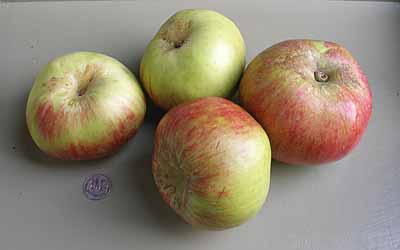A cooking apple with a strong, sour, sharp flavour, this is a large, often irregularly shaped apple, with creamy yellow, acid flesh and deep green skin sometimes flushed with reddish-brown. The flesh disintegrates quickly as it cooks, making it good for apple sauce but not for pies. Some enjoy the mushy purée it produces. It is a triploid, which means that it is a poor pollinator. The first tree was apparently grown from a pip planted by Mary Ann Brailsford some time between 1809 and 1815 in Southwell in Nottinghamshire. The first fruit was produced in 1837. Some years later a local nurseryman, Henry Merryweather, asked the then owner, Mr Bramley, a butcher, for permission to take cuttings. It was named, a little unfairly, after Mr Bramley. Apparently the tree was blown over in a storm early in the 1900s, but a branch emerged from the fallen wood and continues to produce fruit. It was awarded the Royal Horticultural Society First Class Certificate in 1883. Fruits of this late-season apple are picked from early October in South-East England is stored and is at its best from November to March.
